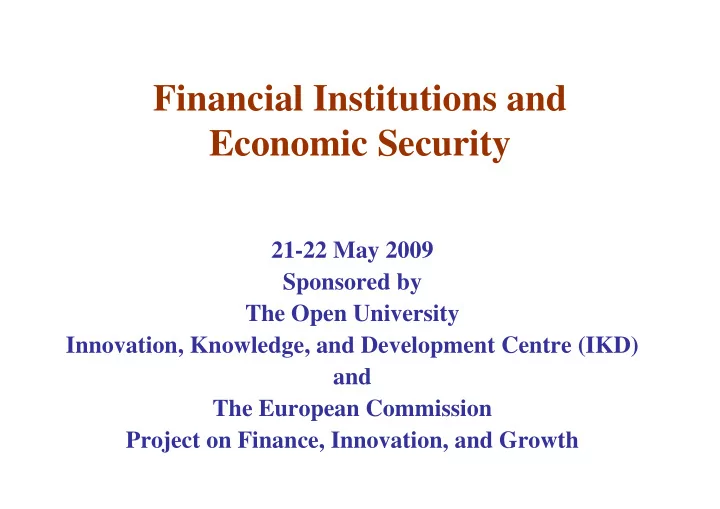

Financial Institutions and Economic Security 21-22 May 2009 Sponsored by The Open University Innovation, Knowledge, and Development Centre (IKD) and The European Commission Project on Finance, Innovation, and Growth
The triple-whammy of economic insecurity
The financialization of the US economy 25% Income shares of the top 1-10%, 1913-2001 20% Income Share (%) 15% 10% 5% Source: Piketty and Saez, AER 2006 0% 1913 1921 1929 1937 1945 1953 1961 1969 1977 1985 1993 2001 Top 1% Top 1-5% Top 5-10%
Growing inequality since the late 1970s The Gini coefficient 0.46 0.44 0.42 Gini coefficient 0.4 0.38 0.36 0.34 0.32 1947 1950 1953 1956 1959 1962 1965 1968 1971 1974 1977 1980 1983 1986 1989 1992 1995 1998 2001 2004 2007
1000 1200 1400 1600 1800 200 400 600 800 0 1/1/1987 1/1/1988 1/1/1989 1/1/1990 1/1/1991 1/1/1992 A volatile stock market 1/1/1993 1/1/1994 1/1/1995 1/1/1996 S&P 500 Index 1/1/1997 1/1/1998 1/1/1999 1/1/2000 1/1/2001 1/1/2002 1/1/2003 1/1/2004 1/1/2005 1/1/2006 1/1/2007 1/1/2008 1/1/2009
A volatile stock market
Three forms of economic insecurity Three propositions: 1. Employment insecurity: associated with maximizing shareholder value – a managerial ideology that enables top corporate executives to downsize their labor forces while distributing corporate revenues to shareholders, themselves included 2. Retirement insecurity: associated with betting on shares traded on the stock market and other volatile financial securities 3. Housing insecurity: associated with the high-rollers of Wall Street gambling on fabricated financial instruments that derive from the fact that masses of people cannot afford to own their homes
The conference on Financial Institutions and Economic Security asks: How can financial institutions be reformed to support rather than undermine economic security? In my view this question is not being asked, at least in the United States. To ask this question requires an understanding of the sources of economic insecurity and an analysis of how an advanced economy can achieve stable and equitable growth, or what I call “sustainable prosperity”. It requires policy-makers to contemplate the banning of certain types of financial activity as simply being too hazardous to our wealth.
Recommend
More recommend